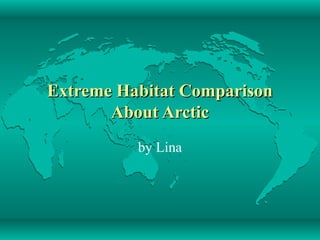
Extreme habitat comparison
- 1. Extreme Habitat Comparison About Arctic by Lina
- 2. Two animals that live in Arctic Arctic Fox Snowy Owl male female
- 3. Arctic animal’s Habitat LOCATION – The Arctic is a polar region that locate at most northern part of the Earth. – The Arctic region consists of a vast, ice-covered ocean, surrounded by treeless surface. CLIMATE – The Arctic's climate is characterized by cold winters and cool summers. – The weather mostly comes in the form of snow. – The Arctic's annual precipitation is low. – High winds often stir up snow, creating the illusion of continuous snowfall. – Average winter temperatures can be as low as −40C and the coldest recorded temperature is approximately −68C. PLANTS – Arctic vegetation is composed of plants such as dwarf shrubs, herbs, lichens and mosses, which all grow relatively close to the ground, forming tundra.
- 4. Things in common Arctic Fox Snowy Owl Design to survive Design to survive Deep and thick fur Warm themselves with thick fur. Reproduction Reproduction Babies are born to clutch 5 to 14 eggs average 5–8babies Both parents care their Both the mother and young and protect the father help to raise their young in a large their nest nest The adult male is Babies are initially virtually pure white, brownish; as they but females and young become older they turn birds have some dark white. spots Diet Diet The arctic fox will This powerful bird feed generally eat any small on lemmings (a type of animal it can find mice) and other small Lemmings (a type of rodents for food during mice) are the most common prey. the breeding season
